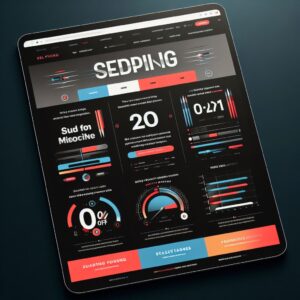Web design is constantly evolving, and each year brings new technologies, creative concepts, and improvements to user experience. In 2024, web design is entering an exciting phase where visual aesthetics and functionality are more important than ever. Whether you have a business that depends on its online presence or work in the web development industry, understanding the top web design trends of 2024 is essential to stay relevant and attract more traffic.
In this article, we’ll explore the 10 most important web design trends for 2024 and how you can implement them on your website to stand out in a highly competitive market.
1. Sustainability-Focused Web Design
Environmental awareness is growing, and this has started to influence the digital world. Users are increasingly concerned about the carbon footprint generated by their online interactions. In 2024, we’ll see a rise in websites designed with sustainability in mind.
Web designers are creating optimized pages that consume less energy, load faster, and are lighter, reducing data usage and server requirements. Elements like dark colors, simple fonts, and minimal animations contribute to lower energy consumption. Additionally, websites are incorporating sustainability messages into their design, helping businesses align with the eco-conscious values of their users.
How to implement it:
- Optimize images and videos to reduce file sizes.
- Use energy-efficient fonts and colors, such as dark backgrounds.
- Encourage visitors to be aware of the environmental impact of their digital actions.
2. Creative and Bold Typography
Typography has become a crucial element of web design, and in 2024, bold and creative fonts will be all the rage. Designers are using large, custom fonts to give personality to their websites and highlight key messages. Typography is no longer just a medium for delivering text; it is now an essential component of both aesthetics and usability.
Serif, sans-serif, and handwritten fonts are being used in innovative ways, breaking away from traditional conventions. Paired with minimalist design, these fonts can make your website look unique and memorable.
How to implement it:
- Use custom fonts that reflect your brand identity.
- Create contrasts between large typography and white space to improve readability.
- Don’t be afraid to use unconventional fonts to grab the user’s attention.
3. Functional Minimalism
Minimalism has been a dominant trend for several years, but in 2024, we’re seeing a focus on functional minimalism. This means not only eliminating visual clutter but also ensuring that every element on the webpage has a clear purpose. Functional minimalism focuses on improving the user experience by simplifying navigation and enhancing page load speeds.
This style is characterized by simple colors, ample white space, and few graphic elements, allowing content and functionality to take center stage. Minimalist sites are also much easier to navigate on mobile devices, improving the user experience across all platforms.
How to implement it:
- Minimize unnecessary graphic elements and focus on a clear structure.
- Prioritize page load speed by eliminating animations or images that don’t add value.
- Ensure that every element on your website serves a specific function.
4. Dark Mode Design
Dark mode continues to be a growing trend for 2024. More and more users prefer dark interfaces due to their visual elegance, battery-saving benefits, and reduced eye strain. Dark mode, in addition to being aesthetically pleasing, also helps highlight important page elements, such as buttons or calls-to-action (CTAs), which can shine with contrasting colors on a dark background.
Many websites now offer the option to switch between light and dark modes, giving users greater control over their experience.
How to implement it:
- Provide an option to switch between light and dark modes.
- Ensure that colors and text remain legible in dark mode.
- Use bright accent colors that stand out against dark backgrounds.
5. Microinteractions
Microinteractions are small visual details that respond to user actions, such as when a button changes color when hovered over or when a notification appears subtly. In 2024, microinteractions will play an even more important role in enhancing the user experience.
These interactions help users better understand how to interact with the site, improving usability and making the experience more enjoyable and memorable. They are especially useful in contact forms, navigation buttons, and loading animations.
How to implement it:
- Add small animations or visual changes when users hover over buttons or interactive elements.
- Use microinteractions to guide users through processes like purchases or form submissions.
- Ensure these interactions are quick and don’t slow down the site.
6. 3D Animations and Interactive Elements
3D animations and interactive graphics are becoming increasingly common on modern websites. In 2024, we’ll see more of these elements, especially with improvements in web rendering technology. 3D animations can make a website look innovative and capture the user’s attention right from the start.
However, it’s important to use them sparingly to avoid sacrificing page load speed or site functionality. Interactive elements such as 3D maps, graphs, or data visualizations will also become more prevalent to offer a more immersive experience.
How to implement it:
- Use lightweight and optimized 3D graphics to avoid impacting load speeds.
- Create interactive animations that respond to user actions, such as sliders or maps.
- Maintain a balance between visual appeal and site functionality.
7. Inclusive Web Design and Accessibility
Web accessibility is becoming more important, and in 2024, a focus on inclusive design will be crucial. Websites need to be accessible to everyone, including those with visual, auditory, or motor impairments. This includes using alternative text for images, creating adaptable designs, and ensuring that websites are navigable via keyboards and screen readers.
Inclusive design not only improves the experience for users with disabilities but also broadens your audience and prevents legal issues related to web accessibility.
How to implement it:
- Ensure all visual elements have alternative text.
- Implement adjustable font sizes and colors with sufficient contrast.
- Test your website with accessibility tools to ensure universal navigation.
8. Visual Storytelling
In 2024, visual storytelling will continue to grow in popularity as a way to tell stories through design. Websites that guide users through a captivating visual narrative not only capture attention but also create an emotional connection with the brand.
Key elements include impactful imagery, smooth animations, and transitions that allow content to flow naturally. Visual storytelling is used to highlight brand values, showcase products or services in an appealing way, and lead the user toward a specific action.
How to implement it:
- Use a visual structure that guides users through a journey, from the homepage to conversion.
- Use images and videos that tell a story, not just decorate the page.
- Ensure that transitions and animations are smooth and not intrusive.
9. Augmented Reality (AR) and Virtual Reality (VR)
With advancing technology, augmented reality and virtual reality are starting to integrate into web design. In 2024, we’ll see more websites using AR and VR to enhance the user experience, especially in sectors like e-commerce, tourism, and education.
For example, users will be able to “try on” products in their environment through AR or explore virtual spaces before making a purchase decision. This provides a unique experience that sets your brand apart from the competition.
How to implement it:
- Research AR or VR options that fit your industry, such as product trials or virtual tours.
- Optimize the AR/VR experience to be accessible from mobile devices.
- Use AR/VR creatively to surprise and delight your users.
10. Artificial Intelligence and Chatbots
Chatbots and AI-driven tools will continue to be a major trend in 2024. These tools improve the user experience by providing real-time assistance and offering solutions quickly without human intervention. Chatbots have become smarter and more personalized, allowing businesses to interact with users more efficiently.
In 2024, we’ll see a shift in how chatbots are used, not only for customer support but also for personalizing the user experience. Websites will be able to predict users’ needs through artificial intelligence (AI) and adapt content or product recommendations based on browsing behavior.
How to implement it:
- Integrate advanced chatbots that offer real-time, personalized support.
- Use AI to analyze user behavior and recommend relevant products or services.
- Ensure that chatbots are intuitive and easy to use, providing clear and helpful responses.
Conclusion
Web design in 2024 will be marked by a convergence of visual aesthetics and functionality, with a strong focus on accessibility, personalization, and user experience. Implementing these trends will not only enhance the appearance of your website but also optimize its performance, speed, and usability, resulting in better conversion rates and customer satisfaction.
From bold typography and dark mode to augmented reality and intelligent chatbots, each of these trends can help you create a more engaging, interactive, and efficient web experience. By incorporating these ideas, you’ll be preparing your site for the challenges and opportunities of 2024, offering your visitors a top-tier online experience.
Remember, staying up-to-date with web design trends is crucial to keeping your site relevant and competitive. But more importantly, ensure that any trend you adopt aligns with your audience’s needs and your business goals.
If you implement these trends correctly, you’ll not only improve the look and functionality of your website but also attract and retain more visitors, boosting your overall online presence. Now is the time to start planning your website redesign for 2024!


